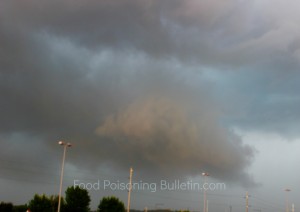Scientists predict many consequences to climate change, such as changes in weather patterns and severity of storms. But a new report titled Assessing the Potential Impacts of Climate Change on Food and Waterborne Diseases in Europe ties climate change to increases in food poisoning outbreaks.
 The report is an assessment of 741 peer-reviewed publications, reports, and scientific sources. From these, the researchers found 1653 “key facts” linking food and waterborne illness pathogens with climate variables.
The report is an assessment of 741 peer-reviewed publications, reports, and scientific sources. From these, the researchers found 1653 “key facts” linking food and waterborne illness pathogens with climate variables.
Climate scientists say that global mean air temperatures are projected to increase by 1.1 to 6.4 degrees C (2 to 11.5 degrees F) this century. Public health is affected by these changes, such as deaths in heat waves, flooding, and increases in illnesses because of shifting distribution of communicable diseases.
Food and waterborne disease incidence is linked to precipitation levels and ambient temperature increases. Higher temperatures accelerate pathogen growth. Extreme rain events can increase the pathogen flow into the water supply. And extended warm weather seasons can compound food handling mistakes. The identified climate variables included:
- Water temperature
- Seasonality
- Air temperature
- Heavy rainfall events
- Precipitation
- Temperature changes
Many food poisoning outbreaks are linked to improper food handling and storage. For instance, perishable food should not be held out of refrigeration longer than two hours. But that time is cut in half as the temperature increases. When the ambient air temperature is over 90 degrees F, perishable food can be out of refrigeration for only one hour. These pathogens were linked to climate variables in the literature.
- Campylobacter is the source of the most prevalent food and waterborne disease in Europe. Most cases are caused by eating raw or undercooked poultry, unpasteurized milk, or contaminated water. The report found that Campylobacter outbreaks show strong seasonality. Outbreaks were cited with the highest frequency in association with air temperature, but the strength of association was not consistent. And Campylobacter outbreaks are often associated with weather events.
- Salmonella infections are more common in summer than winter. The most common sources of this bacteria are from raw poultry, ground beef, eggs, and unpasteurized milk. Salmonella was also cited with high frequency in associated with air temperature. Improper food storage and handling are common causes of salmonellosis. Some scientists think that one-third of salmonellosis cases are caused by increased air temperature. In fact, scientists have found that for every degree the air temperature rises above 43 degrees F, salmonellosis cases rise 12%.
- Cryptosporidium is a parasite found in drinking and recreational water. Most people contract it by swallowing water contaminated with the parasite. Many studies have linked the transmission of Cryptospordium with heavy rainfall events, surface water, and tap water, so the researchers predict that unexpected precipitation events will increase cryptosporidiosis outbreaks. Since severe storms can overwhelm water treatment facilities, Cryptosporidium contaminations may increase.
The report concludes that Campylobacter, Salmonella, and Cryptosporidium should be high priority for future studies and planning for climate changes. Outbreaks of illness caused by these pathogens have a strong public health impact and their incidence is strongly associated with climate change. The authors also say that underreporting and lack of information on the connection between climate change and food and waterborne illness outbreaks could be a risk to public health.
Food Poisoning Bulletin asked Dr. Jan Semenza, author of the report and a public health expert at the European Centre for Disease Control, if increased effort from governments can mitigate the increases in foodborne illness linked to climate change. Dr. Semenza responded, “Scandinavia has one of the most advanced tracking systems for the contamination of meats by E. Coli and Salmonella bacteria. Following a salmonella outbreak in 1957, traced to a meat packing plant, Sweden was the first nation to implement strict government inspections and regulation of the meat-processing and poultry industry to ensure safe food, and minimize the risk of exposure to food-borne pathogens. As a result of such an intervention the prevalence of salmonella in laying hen flocks has reached zero percent, the lowest in the European Union.”




